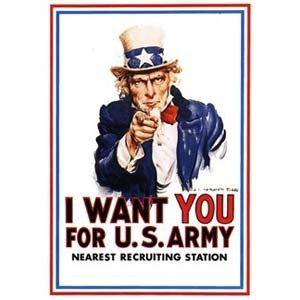For this assignment I thought it would be a good idea to continue the discussion of the Uncle Sam poster discussed in my first On The Town assignment. For that assignment, I argued that the author created the poster to invoke of a sense of patriotism and support for the American military. In turn, this sense of pride in the U.S. and its government would make young men want to join the military and fight for our country. Personification of the U.S. government into the character known as Uncle Sam was a smart choice for J.M. Flagg. The character’s name implies that he is a part of our families. We all know that “blood is thicker than water,” so when your Uncle Sam says something, you listen and respond. In that analysis I also discussed the author’s ability to steer clear of redundancy and create a simple flyer with big meaning. CARP principles like color contrast, character alignment and proximity, and wording all play a part in that.
 Being that this poster uses a character and wording to speak to its audience, I would have to say that it follows the personalization principle. This poster was designed during the times of World War I. Because of its popularity it was also adopted for use during World War II, and remains one of the most well-known posters of our day. (“The Most Famous Poster”) Uncle Sam is the personification of the U.S. government. Like today, during times of war there are people who just don’t see eye to eye with the government’s reasoning for sending troops to battle. This tension can cause an entire country to split and be on opposite ends of an issue, when they should all be supporting a common cause. Using Uncle Sam definitely made people see the government in a different light. This older, gray haired, top hat wearing gentleman became someone we could trust. This trust in the character sparked trust in the government and support for our troops and our wartime efforts.
Being that this poster uses a character and wording to speak to its audience, I would have to say that it follows the personalization principle. This poster was designed during the times of World War I. Because of its popularity it was also adopted for use during World War II, and remains one of the most well-known posters of our day. (“The Most Famous Poster”) Uncle Sam is the personification of the U.S. government. Like today, during times of war there are people who just don’t see eye to eye with the government’s reasoning for sending troops to battle. This tension can cause an entire country to split and be on opposite ends of an issue, when they should all be supporting a common cause. Using Uncle Sam definitely made people see the government in a different light. This older, gray haired, top hat wearing gentleman became someone we could trust. This trust in the character sparked trust in the government and support for our troops and our wartime efforts.
It was not only the character that we thought highly of, but the simple phrase “I Want YOU for the U.S. Army” also spoke to many Americans. Reading this on the poster also speaks to Flagg’s use of the personalization principle to gain audience attention. The statement is in first person narrative. This makes it seem as if Uncle Sam himself is speaking directly to you, the reader. This is important because of the level of respect this character has gained. The words of those you respect are often held in higher regard. We are more apt to respond to something said by those we look up to or trust. This explains the increased military enlistment and support for the government gained during use of the poster.
J.M. Flagg’s use of the personalization principle made this poster both a recruitment tool and a great piece of art. It will be talked about and Uncle Sam will be admired for years to come.
Reference
“The Most Famous Poster.” American Treasures of the Library of Congress. N.p., 27 July 2010. Web. 9 Apr. 2015.